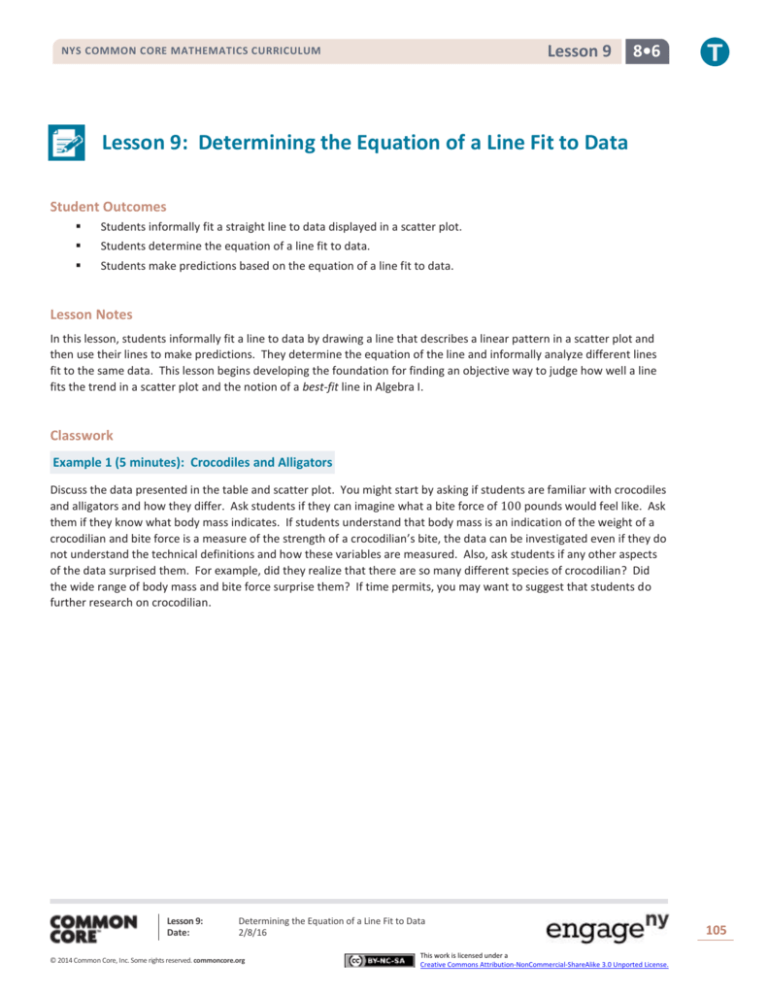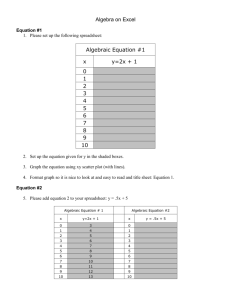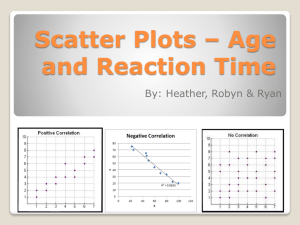
Lesson 9
NYS COMMON CORE MATHEMATICS CURRICULUM
8•6
Lesson 9: Determining the Equation of a Line Fit to Data
Student Outcomes
Students informally fit a straight line to data displayed in a scatter plot.
Students determine the equation of a line fit to data.
Students make predictions based on the equation of a line fit to data.
Lesson Notes
In this lesson, students informally fit a line to data by drawing a line that describes a linear pattern in a scatter plot and
then use their lines to make predictions. They determine the equation of the line and informally analyze different lines
fit to the same data. This lesson begins developing the foundation for finding an objective way to judge how well a line
fits the trend in a scatter plot and the notion of a best-fit line in Algebra I.
Classwork
Example 1 (5 minutes): Crocodiles and Alligators
Discuss the data presented in the table and scatter plot. You might start by asking if students are familiar with crocodiles
and alligators and how they differ. Ask students if they can imagine what a bite force of 100 pounds would feel like. Ask
them if they know what body mass indicates. If students understand that body mass is an indication of the weight of a
crocodilian and bite force is a measure of the strength of a crocodilian’s bite, the data can be investigated even if they do
not understand the technical definitions and how these variables are measured. Also, ask students if any other aspects
of the data surprised them. For example, did they realize that there are so many different species of crocodilian? Did
the wide range of body mass and bite force surprise them? If time permits, you may want to suggest that students do
further research on crocodilian.
Lesson 9:
Date:
Determining the Equation of a Line Fit to Data
2/8/16
© 2014 Common Core, Inc. Some rights reserved. commoncore.org
This work is licensed under a
Creative Commons Attribution-NonCommercial-ShareAlike 3.0 Unported License.
105
Lesson 9
NYS COMMON CORE MATHEMATICS CURRICULUM
8•6
Example 1: Crocodiles and Alligators
Scientists are interested in finding out how different species adapt to finding food sources. One group studied crocodilian
to find out how their bite force was related to body mass and diet. The table below displays the information they
collected on body mass (in pounds) and bite force (in pounds).
Crocodilian Biting
Species
Dwarf Crocodile
Crocodile F
Alligator A
Caiman A
Caiman B
Caiman C
Crocodile A
Nile Crocodile
Crocodile B
Crocodile C
Crocodile D
Caiman D
Indian Gharial Crocodile
Crocodile G
American Crocodile
Crocodile D
Crocodile E
American Alligator
Alligator B
Alligator C
Scaffolding:
Body Mass (Pounds)
𝟑𝟓
𝟒𝟎
𝟑𝟎
𝟐𝟖
𝟑𝟕
𝟒𝟓
𝟏𝟏𝟎
𝟐𝟕𝟓
𝟏𝟑𝟎
𝟏𝟑𝟓
𝟏𝟑𝟓
𝟏𝟐𝟓
𝟐𝟐𝟓
𝟐𝟐𝟎
𝟐𝟕𝟎
𝟐𝟖𝟓
𝟒𝟐𝟓
𝟑𝟎𝟎
𝟑𝟐𝟓
𝟑𝟔𝟓
Bite Force (Pounds)
𝟒𝟓𝟎
𝟐𝟔𝟎
𝟐𝟓𝟎
𝟐𝟑𝟎
𝟐𝟒𝟎
𝟐𝟓𝟓
𝟓𝟓𝟎
𝟔𝟓𝟎
𝟓𝟎𝟎
𝟔𝟎𝟎
𝟕𝟓𝟎
𝟓𝟓𝟎
𝟒𝟎𝟎
𝟏, 𝟎𝟎𝟎
𝟗𝟎𝟎
𝟕𝟓𝟎
𝟏, 𝟔𝟓𝟎
𝟏, 𝟏𝟓𝟎
𝟏, 𝟐𝟎𝟎
𝟏, 𝟒𝟓𝟎
The word crocodilian
refers to any reptile of the
order Crocodylia.
This includes crocodiles,
alligators, caimans, and
gavials. Showing students
a visual aid with pictures
of these animals may help
them understand.
Data Source: PLoS One Greg Erickson biomechanics, Florida State University
As you learned in the previous lesson, it is a good idea to begin by looking at what a scatter plot tells you about the data.
The scatter plot below displays the data on body mass and bite force for the crocodilian in the study.
1800
Bite Force (pounds)
1600
1400
1200
1000
800
600
400
200
0
Lesson 9:
Date:
0
100
200
300
Body Mass (pounds)
400
Determining the Equation of a Line Fit to Data
2/8/16
© 2014 Common Core, Inc. Some rights reserved. commoncore.org
This work is licensed under a
Creative Commons Attribution-NonCommercial-ShareAlike 3.0 Unported License.
106
Lesson 9
NYS COMMON CORE MATHEMATICS CURRICULUM
8•6
Exercises 1–5 (14 minutes)
Exercises 1 through 5 ask students to consider the fit of a line. Each student (or small group of students) draws a line
that would be a good representation of the trend in the data. Students evaluate their lines and the lines of the four
students introduced in Exercise 4.
In Exercise 2, students draw a line they think will be a good representation of the trend in the data. Ask them to
compare their line with other students. As a group, decide who might have the best line, and ask students why they
made that choice. Have groups share their ideas. Point out that it would be helpful to agree on a standard method for
judging the fit of a line. One method is to look at how well the line predicts for the given data or how often it is over or
under the actual or observed value.
Scaffolding:
Exercises 1–6
1.
Describe the relationship between body mass and bite force for the crocodilian shown in the
scatter plot.
As the body mass increases, the bite force tends to also increase.
2.
Point out to ELL students that
the terms body mass and
weight are used
interchangeably in this lesson.
Draw a line to represent the trend in the data. Comment on what you considered in drawing your line.
The line should be as close as possible to the points in the scatter plot. Students explored this idea in Lesson 8.
3.
Based on your line, predict the bite force for a crocodilian that weighs 𝟐𝟐𝟎 pounds. How does this prediction
compare to the actual bite force of the 𝟐𝟐𝟎-pound crocodilian in the data set?
Answers will vary. A reasonable prediction is around 𝟔𝟓𝟎 to 𝟕𝟎𝟎 pounds. The actual bite force was 𝟏, 𝟎𝟎𝟎 pounds,
so the prediction based on the line was not very close for this crocodilian.
4.
Several students decided to draw lines to represent the trend in the data. Consider the lines drawn by Sol, Patti,
Marrisa, and Taylor, which are shown below.
Patti's Line
MP.2
1800
1800
1600
1600
Bite Force (pounds)
Bite Force (pounds)
Sol's Line
1400
1200
1000
800
600
1400
1200
1000
800
600
400
400
200
200
0
0
50
100
150
200
250
300
Body Mass (pounds)
350
400
350
400
0
0
50
100
150
200
250
300
Body Mass (pounds)
350
400
Marrisa's Line
1800
Bite Force (pounds)
1600
1400
1200
1000
800
600
400
200
0
0
50
100
Lesson 9:
Date:
150
200
250
300
Body Mass (pounds)
Determining the Equation of a Line Fit to Data
2/8/16
© 2014 Common Core, Inc. Some rights reserved. commoncore.org
This work is licensed under a
Creative Commons Attribution-NonCommercial-ShareAlike 3.0 Unported License.
107
Lesson 9
NYS COMMON CORE MATHEMATICS CURRICULUM
8•6
For each student, indicate whether or not you think the line would be a good line to use to make predictions. Explain
your thinking.
a.
Sol’s line
In general, it looks like Sol’s line overestimates the bite force for heavier crocodilian and underestimates the
bite force for crocodilian that do not weigh as much.
b.
MP.2
Patti’s line
Patti’s line looks like it fits the data well, so it would probably produce good predictions. The line goes
through the middle of the points in the scatter plot, and the points are fairly close to the line.
c.
Marrisa’s line
It looks like Marrisa’s line overestimates the bite force because almost all of the points are below the line.
d.
Taylor’s line
It looks like Taylor’s line tends to underestimate the bite force. There are many points above the line.
5.
What is the equation of your line? Show the steps you used to determine your line. Based on your equation, what
is your prediction for the bite force of a crocodilian weighing 𝟐𝟎𝟎 pounds?
Answers will vary. Students have learned from previous modules how to find the equation of a line. Anticipate that
students will first determine the slope based on two points on their lines. Students then use a point on the line to
obtain an equation in the form 𝒚 = 𝒎𝒙 + 𝒃 (or 𝒚 = 𝒂 + 𝒃𝒙). Students will use their line to predict a bite force for a
crocodilian that weighs 𝟐𝟎𝟎 pounds. A reasonable answer would be around 𝟖𝟎𝟎 pounds.
Exercise 6 (5 minutes)
6.
Patti drew vertical line segments from two points to the line in her scatter plot. The first point she selected was for
a Dwarf Crocodile. The second point she selected was for an Indian Gharial Crocodile.
1800
Bite Force (pounds)
1600
1400
1200
1000
800
600 Dwarf Croc
400
Indian Gharial Croc
200
0
a.
0
50
100
150
200
250
300
Body Mass (pounds)
350
400
Would Patti’s line have resulted in a predicted bite force that was closer to the actual bite force for the Dwarf
Crocodile or for the Indian Gharial Crocodile? What aspect of the scatter plot supports your answer?
The prediction would be closer to the actual bite force for the Dwarf Crocodile. That point is closer to the line
(the vertical line segment connecting it to the line is shorter) than the point for the Indian Gharial Crocodile.
Lesson 9:
Date:
Determining the Equation of a Line Fit to Data
2/8/16
© 2014 Common Core, Inc. Some rights reserved. commoncore.org
This work is licensed under a
Creative Commons Attribution-NonCommercial-ShareAlike 3.0 Unported License.
108
Lesson 9
NYS COMMON CORE MATHEMATICS CURRICULUM
b.
8•6
Would it be preferable to describe the trend in a scatter plot using a line that makes the differences in the
actual and predicted values large or small? Explain your answer.
It would be better for the differences to be as small as possible. Small differences are closer to the line.
Exercise 7 (14 minutes): Used Cars
This exercise provides additional practice for students. Students use the equation of a line to make predictions and
informally assess the fit of the line.
Exercise 7: Used Cars
7.
The plot below shows the age (in years) and price (in dollars) of used Honda Civic cars that were advertised in a local
newspaper.
16000
15000
14000
13000
Price (dollars)
12000
11000
10000
9000
8000
7000
6000
5000
4000
3000
2000
1000
0
a.
0
1
2
3
4
5
6
7
8 9 10 11 12 13 14 15 16 17 18
Age (years)
Based on the scatter plot above, describe the relationship between the age and price of the used cars.
The older the car, the lower the price tends to be.
b.
Nora drew a line she thought was close to many of the points and found the equation of the line. She used
the points (𝟏𝟑, 𝟔𝟎𝟎𝟎) and (𝟕, 𝟏𝟐𝟎𝟎𝟎) on her line to find the equation. Explain why those points made
finding the equation easy.
16000
15000
14000
13000
Price (dollars)
12000
11000
10000
9000
8000
7000
6000
5000
4000
3000
2000
1000
0
0
1
2
3
4
5
6
7
8 9 10 11 12 13 14 15 16 17 18
Age (years)
The points are at the intersection of the grid lines in the graph, so it is easy to determine the coordinates of
these points.
Lesson 9:
Date:
Determining the Equation of a Line Fit to Data
2/8/16
© 2014 Common Core, Inc. Some rights reserved. commoncore.org
This work is licensed under a
Creative Commons Attribution-NonCommercial-ShareAlike 3.0 Unported License.
109
Lesson 9
NYS COMMON CORE MATHEMATICS CURRICULUM
c.
8•6
Find the equation of Nora’s line for predicting the price of a used car given its age. Summarize the trend
described by this equation.
Using the points, the equation is 𝒚 = −𝟏𝟎𝟎𝟎𝒙 + 𝟏𝟗𝟎𝟎𝟎, or 𝐏𝐫𝐢𝐜𝐞 = −𝟏𝟎𝟎𝟎(𝐚𝐠𝐞) + 𝟏𝟗𝟎𝟎𝟎. The slope of
the line is negative, so the line indicates that the price of used cars decreases as cars get older.
d.
Based on the line, for which car in the data set would the predicted value be farthest from the actual value?
How can you tell?
It would be farthest for the car that is 𝟏𝟎 years old. It is the point in the scatter plot that is farthest from the
line.
What does the equation predict for the cost of a 𝟏𝟎-year-old car? How close was the prediction using the line
to the actual cost of the 𝟏𝟎-year-old car in the data set? Given the context of the data set, do you think the
difference between the predicted price and the actual price is large or small?
e.
The line predicts a 𝟏𝟎-year-old car would cost about $𝟗, 𝟎𝟎𝟎. −𝟏𝟎𝟎𝟎(𝟏𝟎) + 𝟏𝟗𝟎𝟎𝟎 = 𝟗𝟎𝟎𝟎. Compared to
$𝟒, 𝟎𝟒𝟎 for the 𝟏𝟎-year-old car in the data set, the difference would be $𝟒, 𝟗𝟔𝟎. The prediction is off by
about $𝟓, 𝟎𝟎𝟎, which seems like a lot of money, given the prices of the cars in the data set.
Is $𝟓, 𝟎𝟎𝟎 typical of the differences between predicted prices and actual prices for the cars in this data set?
Justify your answer.
f.
No, most of the differences would be much smaller than $𝟓, 𝟎𝟎𝟎. Most of the points are much closer to the
line, and most predictions would be within about $𝟏, 𝟎𝟎𝟎 of the actual value.
Closing (2 minutes)
When you use a line to describe a linear relationship in a data set, what are characteristics of a good fit?
The line should be as close as possible to the points in the scatter plot. The line should go through the
“middle” of the points.
Lesson Summary
A line can be used to represent the trend in a scatter plot.
Evaluating the equation of the line for a value of the independent variable will determine a value
predicted by the line.
A good line for prediction is one that goes through the middle of the points in a scatter plot and for
which the points tend to fall close to the line.
Exit Ticket (5 minutes)
Lesson 9:
Date:
Determining the Equation of a Line Fit to Data
2/8/16
© 2014 Common Core, Inc. Some rights reserved. commoncore.org
This work is licensed under a
Creative Commons Attribution-NonCommercial-ShareAlike 3.0 Unported License.
110
Lesson 9
NYS COMMON CORE MATHEMATICS CURRICULUM
Name ___________________________________________________
8•6
Date____________________
Lesson 9: Determining the Equation of a Line Fit to Data
Exit Ticket
1.
The scatter plot below shows the height and speed of some of the world’s fastest roller coasters. Draw a line that
you think is a good fit for the data.
2.
Find the equation of your line. Show your steps.
3.
For the two roller coasters identified in the scatter plot, use the line to find the approximate difference between the
observed speeds and the predicted speeds.
Lesson 9:
Date:
Determining the Equation of a Line Fit to Data
2/8/16
© 2014 Common Core, Inc. Some rights reserved. commoncore.org
This work is licensed under a
Creative Commons Attribution-NonCommercial-ShareAlike 3.0 Unported License.
111
Lesson 9
NYS COMMON CORE MATHEMATICS CURRICULUM
8•6
Exit Ticket Sample Solutions
1.
The scatter plot below shows the height and speed of some of the world’s fastest roller coasters. Draw a line that
you think is a good fit for the data.
Students would draw a line based on the goal of a best fit for the given scatter plot. A possible line is drawn below.
130
Kinga Ka
Speed (mph)
120
110
100
Top Thrill
90
80
0
2.
0
200
250
300
350
400
Maximum Height (feet)
450
500
Find the equation of your line. Show your steps.
Answers will vary based on the line drawn. Let 𝑺 equal the speed of the roller coaster and 𝑯 equal the maximum
height of the roller coaster.
𝒎=
𝟏𝟏𝟓 − 𝟖𝟓
≈ 𝟎. 𝟏𝟏
𝟓𝟎𝟎 − 𝟐𝟐𝟓
𝑺 = 𝟎. 𝟏𝟏𝑯 + 𝒃
𝟖𝟓 = 𝟎. 𝟏𝟏(𝟐𝟐𝟓) + 𝒃
𝒃 ≈ 𝟔𝟎
Therefore, the equation of the line drawn in Problem 1 is 𝑺 = 𝟎. 𝟏𝟏𝑯 + 𝟔𝟎.
3.
For the two roller coasters identified in the scatter plot, use the line to find the approximate difference between the
observed speeds and the predicted speeds.
Answers will vary depending on the line drawn by a student or the equation of the line. For the Top Thrill, the
maximum height is about 𝟒𝟏𝟓 feet and the speed about 𝟏𝟎𝟎 miles per hour. The line indicated in Problem 2 predicts
a speed of 𝟏𝟎𝟔 miles per hour, so the difference is about 𝟔 miles per hour over the actual speed. For the Kinga Ka,
the maximum height is about 𝟒𝟐𝟒 feet with a speed of 𝟏𝟐𝟎 miles per hour. The line predicts a speed of about
𝟏𝟎𝟕 miles per hour, for a difference of 𝟏𝟑 miles per hour under the actual speed. (Students can use the graph or the
equation to find the predicted speed.)
Lesson 9:
Date:
Determining the Equation of a Line Fit to Data
2/8/16
© 2014 Common Core, Inc. Some rights reserved. commoncore.org
This work is licensed under a
Creative Commons Attribution-NonCommercial-ShareAlike 3.0 Unported License.
112
Lesson 9
NYS COMMON CORE MATHEMATICS CURRICULUM
8•6
Problem Set Sample Solutions
1.
Monopoly is a popular board game in many countries. The scatter plot below shows the distance from “Go” to a
property (in number of spaces moving from “Go” in a clockwise direction) and the price of the properties on the
Monopoly board. The equation of the line is 𝑷 = 𝟖𝒙 + 𝟒𝟎, where 𝑷 represents the price (in Monopoly dollars) and
𝒙 represents the distance (in number of spaces).
Distance from “Go”
(Number of Spaces)
𝟏
𝟑
𝟓
𝟔
𝟖
𝟗
𝟏𝟏
𝟏𝟐
𝟏𝟑
𝟏𝟒
𝟏𝟓
𝟏𝟔
𝟏𝟖
𝟏𝟗
Price of Property
(Monopoly Dollars)
𝟔𝟎
𝟔𝟎
𝟐𝟎𝟎
𝟏𝟎𝟎
𝟏𝟎𝟎
𝟏𝟐𝟎
𝟏𝟒𝟎
𝟏𝟓𝟎
𝟏𝟒𝟎
𝟏𝟔𝟎
𝟐𝟎𝟎
𝟏𝟖𝟎
𝟏𝟖𝟎
𝟐𝟎𝟎
Distance from “Go”
(Number of Spaces)
𝟐𝟏
𝟐𝟑
𝟐𝟒
𝟐𝟓
𝟐𝟔
𝟐𝟕
𝟐𝟖
𝟐𝟗
𝟑𝟏
𝟑𝟐
𝟑𝟒
𝟑𝟓
𝟑𝟕
𝟑𝟗
Price of Property
(Monopoly Dollars)
𝟐𝟐𝟎
𝟐𝟐𝟎
𝟐𝟒𝟎
𝟐𝟎𝟎
𝟐𝟔𝟎
𝟐𝟔𝟎
𝟏𝟓𝟎
𝟐𝟖𝟎
𝟑𝟎𝟎
𝟑𝟎𝟎
𝟑𝟐𝟎
𝟐𝟎𝟎
𝟑𝟓𝟎
𝟒𝟎𝟎
Price of Property vs. Distance from “Go” in Monopoly
a.
Use the equation to find the difference (observed value − predicted value) for the most expensive property
and for the property that is 𝟑𝟓 spaces from “Go.”
The most expensive property is 𝟑𝟗 spaces from “Go” and costs $𝟒𝟎𝟎. The price predicted by the line would be
𝟖(𝟑𝟗) + 𝟒𝟎, or $𝟑𝟓𝟐. Observed price − predicted price would be $𝟒𝟎𝟎 − $𝟑𝟓𝟐 = $𝟒𝟖. The price predicted
for 𝟑𝟓 spaces from “Go” would be 𝟖(𝟑𝟓) + 𝟒𝟎 = $𝟑𝟐𝟎. Observed price − predicted price would be $𝟐𝟎𝟎 −
$𝟑𝟐𝟎 = −$𝟏𝟐𝟎.
b.
Five of the points seem to lie in a horizontal line. What do these points have in common? What is the
equation of the line containing those five points?
These points all have the same price. The equation of the horizontal line through those points would be
Price = $𝟐𝟎𝟎.
Lesson 9:
Date:
Determining the Equation of a Line Fit to Data
2/8/16
© 2014 Common Core, Inc. Some rights reserved. commoncore.org
This work is licensed under a
Creative Commons Attribution-NonCommercial-ShareAlike 3.0 Unported License.
113
Lesson 9
NYS COMMON CORE MATHEMATICS CURRICULUM
c.
8•6
Four of the five points described in part (b) are the railroads. If you were fitting a line to predict price with
distance from “Go,” would you use those four points? Why or why not?
Answers will vary. Because the four points are not part of the overall trend in the price of the properties, I
would not use them to determine a line that describes the relationship. I can show this by finding the total
error to measure the fit of the line.
2.
The table below gives the coordinates of the five points shown in the scatter plots that follow. The scatter plots
show two different lines.
Data Point
A
B
C
D
E
Independent Variable
𝟐𝟎
𝟐𝟐
𝟐𝟓
𝟑𝟏
𝟒𝟎
Response Variable
𝟐𝟕
𝟐𝟏
𝟐𝟒
𝟏𝟖
𝟏𝟐
Line 1
28
28
𝒚=
y =−𝟎.
-0.9 𝟗𝒙
+ 45+ 𝟒𝟓
26
22
20
18
16
14
24
22
20
18
16
14
12
12
10
0
𝒚y =
−𝟎.+𝟕𝒙
= -0.7
40 + 𝟒𝟎
26
24
Response Variable
Response Variable
Line 2
10
0
a.
b.
20
25
30
Independent Variable
35
40
0
0
20
25
30
Independent Variable
35
40
Find the predicted response values for each of the two lines.
Independent
Observed Response
𝟐𝟎
𝟐𝟐
𝟐𝟓
𝟑𝟏
𝟒𝟎
𝟐𝟕
𝟐𝟏
𝟐𝟒
𝟏𝟖
𝟏𝟐
Response Predicted
by Line 1
𝟐𝟕
𝟐𝟓. 𝟐
𝟐𝟐. 𝟓
𝟏𝟕. 𝟏
𝟗
Response Predicted
by Line 2
𝟐𝟔
𝟐𝟒. 𝟔
𝟐𝟐. 𝟓
𝟏𝟖. 𝟑
𝟏𝟐
For which data points is the prediction based on Line 1 closer to the actual value than the prediction based on
Line 2?
Only for data point A. For data point C, both lines are off by the same amount.
c.
Which line (Line 1 or Line 2) would you select as a better fit?
Line 2 because it is closer to more of the data points.
Lesson 9:
Date:
Determining the Equation of a Line Fit to Data
2/8/16
© 2014 Common Core, Inc. Some rights reserved. commoncore.org
This work is licensed under a
Creative Commons Attribution-NonCommercial-ShareAlike 3.0 Unported License.
114
Lesson 9
NYS COMMON CORE MATHEMATICS CURRICULUM
3.
8•6
The scatter plots below show different lines that students used to model the relationship between body mass (in
pounds) and bite force (in pounds) for crocodilian.
a.
Match each graph to one of the equations below and explain your reasoning. Let 𝑩 represent bite force (in
pounds) and 𝑾 represent body mass (in pounds).
Equation 1
Equation 2
𝑩 = 𝟑. 𝟐𝟖𝑾 + 𝟏𝟐𝟔
𝑩 = 𝟑. 𝟎𝟒𝑾 + 𝟑𝟓𝟏
Equation 3
𝑩 = 𝟐. 𝟏𝟔𝑾 + 𝟐𝟔𝟕
Equation: 3
Line 1
1800
1600
Bite Force (pounds)
The intercept of 𝟐𝟔𝟕 appears to match the
graph, which has the second largest
intercept.
1400
1200
1000
800
600
400
200
0
0
50
100
150
200
250
300
Body Mass (pounds)
Equation: 2
350
400
350
400
Line 2
1800
1600
Bite Force (pounds)
The intercept of Equation 2 is larger, so it
matches Line 2, which has a 𝒚-intercept
closer to 𝟒𝟎𝟎.
1400
1200
1000
800
600
400
200
0
Lesson 9:
Date:
0
50
100
150
200
250
300
Body Mass (pounds)
Determining the Equation of a Line Fit to Data
2/8/16
© 2014 Common Core, Inc. Some rights reserved. commoncore.org
This work is licensed under a
Creative Commons Attribution-NonCommercial-ShareAlike 3.0 Unported License.
115
Lesson 9
NYS COMMON CORE MATHEMATICS CURRICULUM
8•6
Equation: 1
The intercept of Equation 1 is the smallest,
which seems to match the graph.
b.
Which of the lines would best fit the trend in the data? Explain your thinking.
Answers will vary. Line 3 would be better than the other two lines. Line 1 is not a good fit for larger weights,
and Line 2 is above nearly all of the points and pretty far away from most of them. It looks like Line 3 would
be closer to most of the points.
4.
Comment on the following statements:
a.
A line modeling a trend in a scatter plot always goes through the origin.
Some trend lines will go through the origin, but others may not. Often, the value (𝟎, 𝟎) does not make sense
for the data.
b.
If the response variable increases as the independent variable decreases, the slope of a line modeling the
trend will be negative.
If the trend is from the upper left to the lower right, the slope for the line will be negative because for each
unit increase in the independent variable, the response will decrease.
Lesson 9:
Date:
Determining the Equation of a Line Fit to Data
2/8/16
© 2014 Common Core, Inc. Some rights reserved. commoncore.org
This work is licensed under a
Creative Commons Attribution-NonCommercial-ShareAlike 3.0 Unported License.
116









